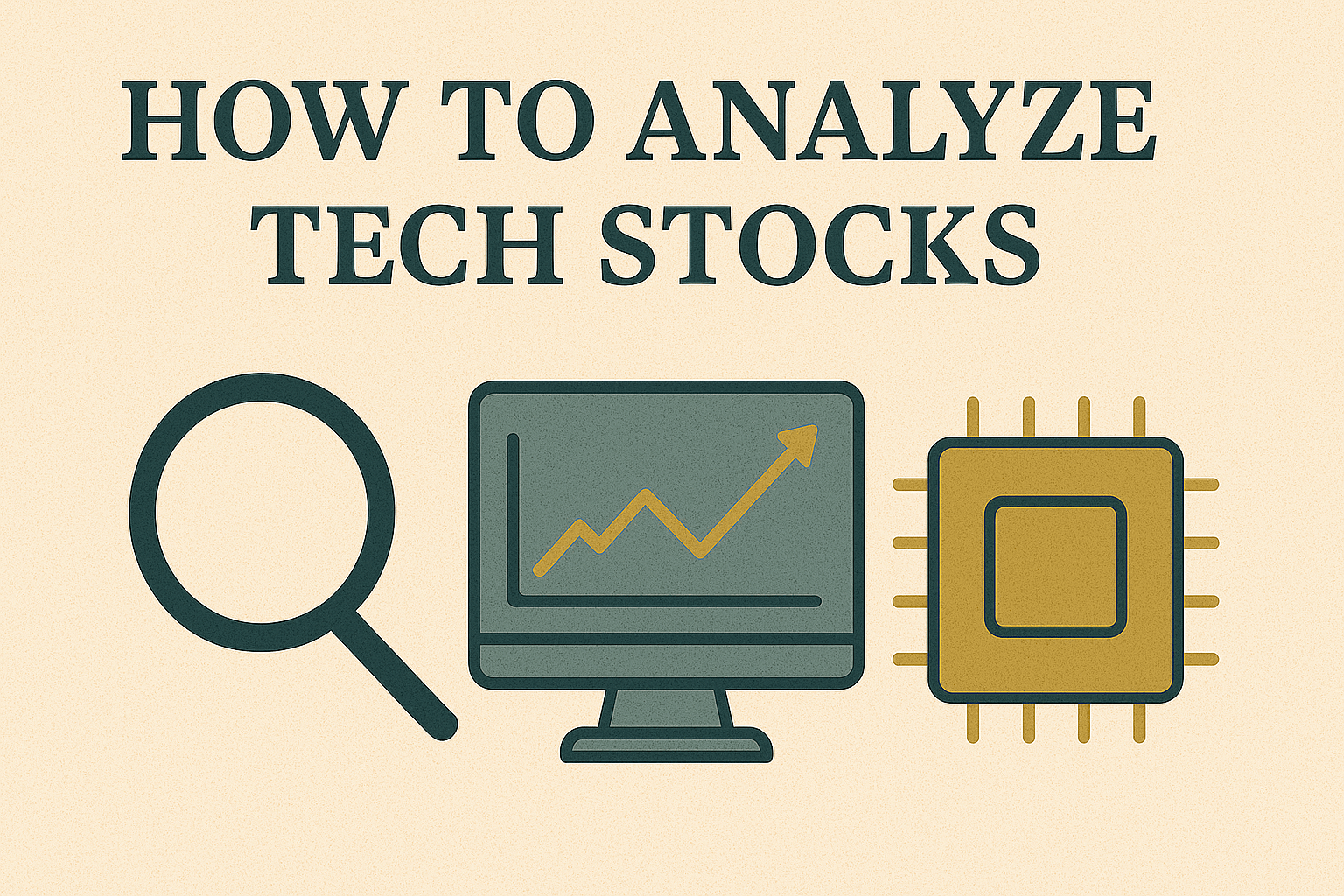Your cart is currently empty!
How to Analyze Tech Stocks

How to Analyze Tech Stocks that can offer investors a structured way to evaluate high-growth companies beyond simply examining top-line revenue. In competitive markets like the US, UK, Italy, and Europe, revenue growth alone can mask underlying risks such as thinning profit margins or inconsistent cash flow. Consequently, a well-rounded approach to Tech Stock Analysis empowers investors to make informed decisions that balance growth potential with financial stability. Moreover, this guide will integrate insights from leading resources such as the Palantir Stock Deep Dive and core principles from personal finance strategies like Budgeting 101 for Gen Z to illustrate how broader financial discipline supports successful equity selection.
Importance of Tech Stock Analysis
Tech companies often reinvest heavily in research, marketing, and infrastructure to stay ahead of innovation cycles. Therefore, focusing exclusively on revenue growth can lead investors to overlook critical factors such as gross margin stability or research and development intensity. For example, a firm may report surging sales but simultaneously experience escalating customer acquisition costs that undermine long-term profitability. By using Tech Stock Analysis to examine multiple financial dimensions, investors in varied markets—from London to Milan—can build resilient portfolios that weather volatility and shifting consumer trends.
Gross Margin and Operating Expenses
Gross margin represents the percentage of revenue retained after deducting the cost of goods sold. In Tech Stock Analysis, a consistently healthy gross margin suggests that a company controls production or delivery costs effectively. Furthermore, monitoring operating expenses—such as sales, general, and administrative costs—reveals whether a firm scales its overhead in line with revenue. If operating expenses grow faster than sales, profitability can erode despite top-line strength. Therefore, investors should track trends in both gross margin and operating expenses to ensure that growth remains sustainable over time.
Cash Flow Analysis
While revenue and earnings figures offer snapshots of a company’s performance, cash flow analysis provides insight into its liquidity and operational health. Free cash flow, defined as net operating cash flow minus capital expenditures, indicates the funds available for strategic initiatives such as acquisitions or debt reduction. In high-interest rate climates, companies with robust free cash flow enjoy greater flexibility to navigate rising borrowing costs, as highlighted in our discussion on Navigating Market Volatility. Consequently, Tech Stock Analysis must incorporate detailed cash flow metrics to assess a company’s ability to fund innovation and return value to shareholders under varying economic conditions.
Research and Development Intensity
Tech firms often allocate a significant portion of revenue to research and development (R&D) to maintain competitive advantage. In the context of Tech Stock Analysis, the R&D intensity ratio—R&D expenditure divided by revenue—serves as a gauge of a company’s commitment to innovation. However, investors should balance high R&D intensity against the timeline for commercialization. Excessive R&D spending without clear product pipelines can strain a firm’s finances. Therefore, Tech Stock Analysis should evaluate both R&D intensity and the clarity of product roadmaps to distinguish companies likely to convert investment into profitable offerings.
Customer Acquisition Cost and Churn
In sectors driven by subscription models or digital platforms, understanding customer acquisition cost (CAC) and churn rate is vital. Tech Stock Analysis examines the average cost to acquire a new customer alongside the percentage of customers who discontinue service within a given period. A rising CAC or elevated churn can signal market saturation or competitive pressures that erode future revenue potential. Conversely, a company that achieves scalable marketing efficiency while reducing churn demonstrates operational strength. Therefore, diligent Tech Stock Analysis tracks these metrics to ensure that user growth translates into sustainable financial performance.
Market Share and Competitive Edge
Assessing market share helps investors understand a tech company’s position within its industry. In Tech Stock Analysis, a firm that consistently gains market share often benefits from network effects, brand recognition, or unique technology advantages. However, market dynamics can shift rapidly as new entrants emerge. That is why Tech Stock Analysis also evaluates barriers to entry such as patents, proprietary algorithms, and ecosystem partnerships. By focusing on both current market share and defensibility factors, investors can identify companies poised to maintain leadership even as competitive challenges evolve.
Balance Sheet Strength
A strong balance sheet underpins resilience during economic downturns or rapid expansion phases. Within Tech Stock Analysis, key balance sheet indicators include cash reserves, debt levels, and the debt-to-equity ratio. Companies with ample cash on hand and manageable debt obligations can invest in growth opportunities without overreliance on external financing. This approach parallels strategies in personal finance, where excess cash reserves support stability—an idea reinforced in our guide to Recession-Proofing Your Finances. Consequently, investors should favor tech stocks whose balance sheets reflect prudence and flexibility.
Valuation Multiples and Relative Valuation
Valuation multiples such as price-to-earnings (P/E) and enterprise value-to-sales (EV/Sales) provide benchmarks for comparing tech stocks within a sector. In Tech Stock Analysis, using relative valuation enables investors to identify overvalued or undervalued opportunities based on industry norms. However, multiples must be contextualized by growth rates and profitability trajectories. A high P/E ratio may be justifiable for a firm delivering superior revenue expansion and margin improvement. Therefore, sophisticated Tech Stock Analysis balances multiple valuation metrics against projected performance to avoid both value traps and growth illusions.
Growth Drivers and Product Pipeline
Understanding the drivers behind future revenue is central to Tech Stock Analysis. For instance, emerging trends in artificial intelligence, cloud computing, and the creator economy shape growth trajectories across tech industries. Investors can explore detailed strategies in our overview of Investing in the Creator Economy to appreciate how social platforms and digital content monetization models influence company forecasts. Moreover, analyzing a firm’s product pipeline and go-to-market plans reveals the likelihood of sustained innovation translating into market share gains. Thus, effective Tech Stock Analysis combines trend identification with rigorous pipeline assessment.
Macro Factors Affecting Tech Stocks
The performance of tech stocks also hinges on broader economic indicators and policy environments. Rising interest rates, inflation trends, and global supply chain dynamics all influence corporate costs and consumer demand. In Tech Stock Analysis, referencing key variables such as consumer price index movements, central bank policy statements, and semiconductor supply forecasts can illuminate potential headwinds or tailwinds. For a comprehensive review of macroeconomic signals, our article on Key Economic Indicators provides valuable context. Additionally, alternative financing channels like private credit play an increasingly important role when traditional lending tightens. Insights from the Private Credit Guide illustrate how debt markets adjust to shifting liquidity conditions, thereby affecting tech firms’ capital structures and funding costs.
Integrating Personal Finance Principles
Although Tech Stock Analysis focuses on corporate metrics, individual investors benefit from applying personal finance best practices. Effective budgeting and credit management ensure that investors can seize opportunities without overleveraging. Likewise, strategies such as saving for a home—outlined in our Saving for a Home guide—demonstrate long-term goal setting that parallels portfolio planning. In addition, maintaining healthy credit, as discussed in Credit Repair & Coaching, enhances access to favorable financing options, whether for mortgages or margin accounts. Therefore, Tech Stock Analysis thrives when paired with disciplined financial habits.
Digital Assets and Estate Planning
Tech equities often represent the cornerstone of modern investment portfolios, yet they coexist with alternative digital assets and estate considerations. As crypto technology and tokenization advance, investors must evaluate how equity positions align with broader digital asset strategies. Our Estate Planning for Digital Assets article explains legal frameworks for securing digital investments and ensuring seamless wealth transfer. Consequently, Tech Stock Analysis can form part of a holistic asset allocation process that encompasses equities, fixed income, digital tokens, and tangible holdings.
Conclusion: Tech Stock Analysis in Practice
In summary, Tech Stock Analysis demands a multifaceted evaluation that reaches well beyond revenue figures. By examining gross margins, cash flows, R&D intensity, and customer metrics, investors cultivate a nuanced understanding of corporate health. Moreover, incorporating valuation multiples, product pipelines, and macroeconomic indicators refines decision-making. Ultimately, pairing these analytical techniques with personal finance discipline and estate planning ensures a resilient approach to wealth growth. Whether you are based in New York, London, Rome, or Berlin, mastering Tech Stock Analysis empowers you to navigate market complexities and build a portfolio positioned for long-term success.

Mr. Rajeev Prakash
Rajeev is a well-known astrologer based in central India who has a deep understanding of both personal and mundane astrology. His team has been closely monitoring the movements of various global financial markets, including equities, precious metals, currency pairs, yields, and treasury bonds.
Featured Post
Financial Astrology Terminal
The Financial Astrology Terminal is a web platform that combines real-time U.S. market data (S&P 500, Nasdaq, Dow, Russell, key stocks and commodities like gold and silver) with planetary cycles, giving traders and investors astro-timing signals on top of normal charts and analysis.
